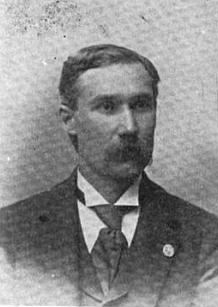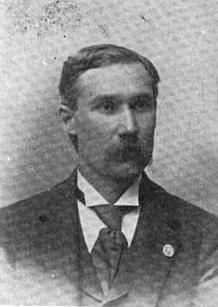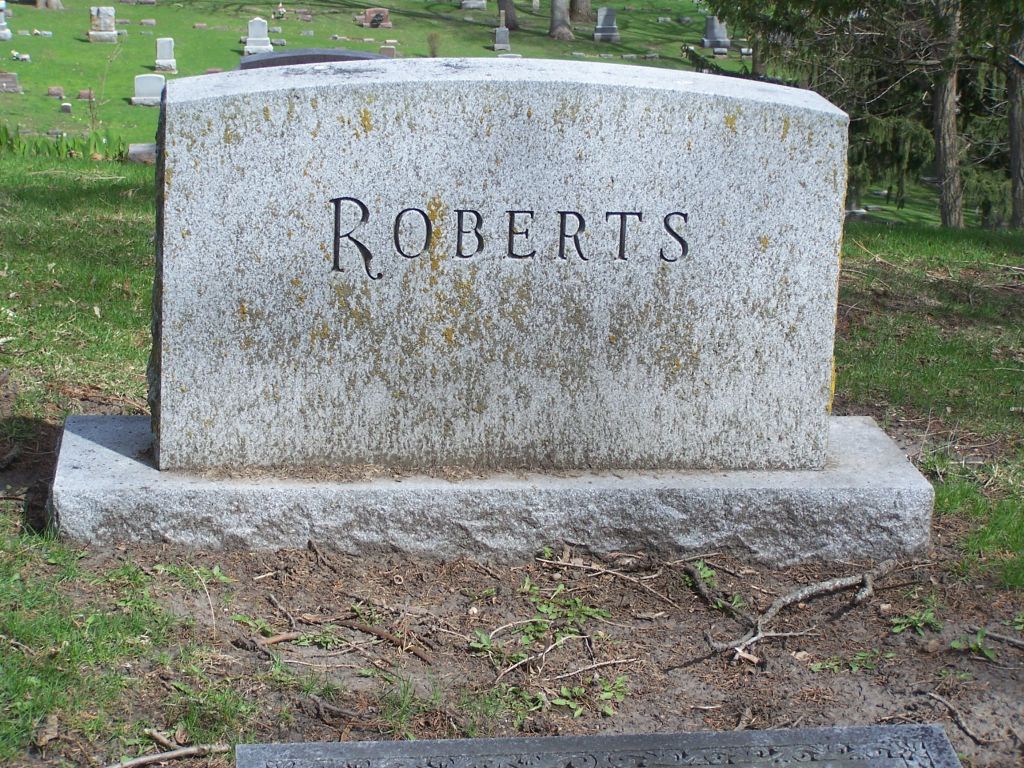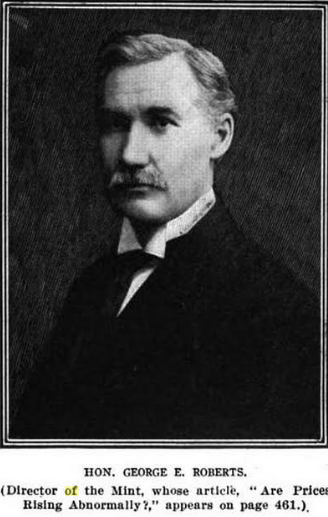Roberts was recognized as a strong, handsome, and distinguished man who enjoyed an accomplished life of diversity, achievement and respect. He was a journalist, the owner of the Messenger newspaper, a renowned economist, a banker, an author and a director of the U.S. Mint.
George Roberts's early introduction to the newspaper business set him on a course that would shape the rest of his life. At the age of 16, Roberts began working as a printer's apprentice at the Fort Dodge Times; later he worked at the Fort Dodge Messenger as well. He briefly served as the city editor of the Sioux City Journal. In 1878 he purchased the Messenger and became the paper's editor. In 1902 he and a partner purchased two Des Moines-based papers, the Iowa State Register and the Des Moines Leader, which they merged into the large and influential Des Moines Register and Leader. Because of his prominence in the state as an editor and within the state Republican Party, in 1883 he was elected State Printer of Iowa, a position he held until 1889. In 1902 he drafted the Iowa Republican Party's position on tariffs, which criticized protectionism and instead advocated a "policy of reciprocity" among nations.
George Roberts became an influential member of his party. He was consulted by its leaders and then became a leader. He helped to write its platform and shape its policies. Even though Roberts was a staunch fiscal conservative, he was absolutely a non-partisan on many of his views. He criticized the financial policies of the Republican administrations, following the war, as severely as he has criticized the financial policies of the New Deal.
As a newspaper editor, Roberts developed an interest and expertise in economic and monetary policy, which he addressed in numerous editorials published in the Messenger. Those newspaper columns were the beginning of what would be a lifetime of writing and lecturing on economic matters of national and international importance. In 1894 he published Coin at School in Finance, a rebuttal to Coin's Financial School, in which its author, William H. Harvey, advocated a free silver position.
Roberts' little book entitled "Coin at School in Finance" was written in the language of the kindergarten— crudely but effectively illustrated. The scene was a county schoolhouse. Harvey was seated beside the teacher's desk on a dunce block, with a dunce cap on his head. The teacher was Uncle Sam. The book written in simple terms about economics and the fallacies of government economic policy specifically regarding the government's lack of an ideal system of currency in the 1890s. The widespread circulation of this little book may have been due to the fact that it was written so clearly and so simply that a child could understand it. Roberts's nationally distributed publication was an important and timely contribution to the debate about free silver, which was central to the presidential campaign of 1896 and the defeat of William Jennings Bryan. Roberts's other publications, including Money, Wages and Prices (1895) and Iowa and the Silver Question (1896), also brought him national attention.
In 1898 Secretary of the Treasury Lyman J. Gage recommended to President McKinley that he name Roberts director of the U.S. Mint. President Theodore Roosevelt reappointed Roberts to the Mint in 1903, and he served in that capacity until July 1907. Roberts served a third term as director of the Mint when he was appointed by President William Howard Taft in 1910. During Roberts's tenure, the Denver Mint was established, numerous technical innovations were introduced to enhance the efficiency of the manufacturing process, and the U.S. Mint issued the famous Buffalo nickel, designed by sculptor James Earle Fraser.
George Roberts also had a long and distinguished banking career. From 1907 to 1910 (between his second and third terms as director of the Mint), he was president of the Commercial National Bank in Chicago. Out of respect for his knowledge as an economist, George Roberts was invited to become the advisor to the president of the National City Bank of New York which was the largest bank in the United States. A few years later in 1919 he was made vice president and the bank's top economist. From 1931 to the time of his death he was the institution's economic adviser. One of his most important contributions at the National City Bank was transforming the company's small investment market circular into a widely read and influential investment bulletin, the Monthly Economic Letter. Serving as its editor from 1914 to 1940, Roberts wrote about world events, economic affairs, and national and international finances. The Monthly Economic Letter had a circulation of 150,000 at the time of his death, and, according to the New York Times 's financial editor, was second only to the Economist as an authority on financial matters.
Mr. Roberts' fame is not only national but international. He lectured widely on topics such as price controls, labor relations, agricultural policy and the national debt. He spoke before innumerable business associations, economic clubs and at many colleges and universities. He also played a role in international monetary matters. In 1929 he headed a delegation of financers who traveled to Panama to investigate that country's financial situation. From 1930 to 1932, he was a member of the Gold Delegation of the Financial Committee of the League of Nations; he was one of a distinguished body of experts who were called upon in consultation by the Royal Commission on Indian currency and finance.
In the last forty years of his life, George Roberts was recognized as a highly respected economist. Noting that economics is not an exact science, Roberts advocated foundation economic laws like the law of diminishing returns and the law of supply and demand, which can never be suspended or repealed except by tyrannical fiat. George Roberts espoused sound doctrine and economic theory for the period of his time even though his advice often when unheeded by politicians and government leaders.
Roberts' personal and very basic philosophy of economics is best demonstrated by the following text abstracted from one of his well-known articles on economic law:
The highest state of prosperity results from a balanced state of industry. We know that in order to obtain the best results in an individual industry all departments of the industry must be in balanced relations to each other, and so there is a normal equilibrium throughout industry which must be maintained in order to have prosperity. All business in the last analysis is simply an exchange of goods and services, and this being true all branches of industry must be so related that the products of every industry will be absorbed and consumed by the people in the other industries. This means that their interests, instead of being antagonistic, are necessarily interlocked and dependent upon each other. An injury to one affects them all….It is not only unfair but unworkable, for the economic law does not permit it. If the wage-earners could pick their gains out of the sky they might enjoy them, but when they come out of other sections of the population the loss of purchasing power by the latter inevitably forces wage-earners out of employment, as witnessed in the last two years. It has upset the "sound, fair balance" in the industrial system…. No upward trend can take place unless all go up. No permanency of any trend can be guaranteed, unless we have sound and fair balance between all the units of our economic body….The whole situation affords another demonstration that the basis of sound economics is the moral law. In truth, the economic law and the moral law are one and the same."
Roberts married Georgena Kirkup on November 10, 1885, and they had two sons and a daughter.
Even though George Roberts spent that forty years of his life on the east coast, he always claimed that he still loved Iowa and thinks of Iowa as his home. George E. Roberts died at his home in Larchmont, New York, on June 6, 1948, at the age of 90.
Sources:
*Mohr, Paula A. "Roberts, George Evan" The Biographical Dictionary of Iowa. University of Iowa Press, 2009. Web. 13 August 2019
*The Annals of Iowa – Volume 29 | Number 6 (Fall 1948)…. State Historical Society of Iowa
Note: Roberts's papers are at the State Historical Society of Iowa, Iowa City. Following his death, excerpts of his writings from the Monthly Economic Letter were published by the National City Bank of New York in a pamphlet titled "In Memory of George E. Roberts, 1857–1948." The New York Times published an obituary, 6/8/1948, and a two-part tribute summarizing his legacy and contributions titled "Apostle of Common Sense," 6/14/1948 and 6/21/1948.
Contributor: Sam Hartman (49330347)
Roberts was recognized as a strong, handsome, and distinguished man who enjoyed an accomplished life of diversity, achievement and respect. He was a journalist, the owner of the Messenger newspaper, a renowned economist, a banker, an author and a director of the U.S. Mint.
George Roberts's early introduction to the newspaper business set him on a course that would shape the rest of his life. At the age of 16, Roberts began working as a printer's apprentice at the Fort Dodge Times; later he worked at the Fort Dodge Messenger as well. He briefly served as the city editor of the Sioux City Journal. In 1878 he purchased the Messenger and became the paper's editor. In 1902 he and a partner purchased two Des Moines-based papers, the Iowa State Register and the Des Moines Leader, which they merged into the large and influential Des Moines Register and Leader. Because of his prominence in the state as an editor and within the state Republican Party, in 1883 he was elected State Printer of Iowa, a position he held until 1889. In 1902 he drafted the Iowa Republican Party's position on tariffs, which criticized protectionism and instead advocated a "policy of reciprocity" among nations.
George Roberts became an influential member of his party. He was consulted by its leaders and then became a leader. He helped to write its platform and shape its policies. Even though Roberts was a staunch fiscal conservative, he was absolutely a non-partisan on many of his views. He criticized the financial policies of the Republican administrations, following the war, as severely as he has criticized the financial policies of the New Deal.
As a newspaper editor, Roberts developed an interest and expertise in economic and monetary policy, which he addressed in numerous editorials published in the Messenger. Those newspaper columns were the beginning of what would be a lifetime of writing and lecturing on economic matters of national and international importance. In 1894 he published Coin at School in Finance, a rebuttal to Coin's Financial School, in which its author, William H. Harvey, advocated a free silver position.
Roberts' little book entitled "Coin at School in Finance" was written in the language of the kindergarten— crudely but effectively illustrated. The scene was a county schoolhouse. Harvey was seated beside the teacher's desk on a dunce block, with a dunce cap on his head. The teacher was Uncle Sam. The book written in simple terms about economics and the fallacies of government economic policy specifically regarding the government's lack of an ideal system of currency in the 1890s. The widespread circulation of this little book may have been due to the fact that it was written so clearly and so simply that a child could understand it. Roberts's nationally distributed publication was an important and timely contribution to the debate about free silver, which was central to the presidential campaign of 1896 and the defeat of William Jennings Bryan. Roberts's other publications, including Money, Wages and Prices (1895) and Iowa and the Silver Question (1896), also brought him national attention.
In 1898 Secretary of the Treasury Lyman J. Gage recommended to President McKinley that he name Roberts director of the U.S. Mint. President Theodore Roosevelt reappointed Roberts to the Mint in 1903, and he served in that capacity until July 1907. Roberts served a third term as director of the Mint when he was appointed by President William Howard Taft in 1910. During Roberts's tenure, the Denver Mint was established, numerous technical innovations were introduced to enhance the efficiency of the manufacturing process, and the U.S. Mint issued the famous Buffalo nickel, designed by sculptor James Earle Fraser.
George Roberts also had a long and distinguished banking career. From 1907 to 1910 (between his second and third terms as director of the Mint), he was president of the Commercial National Bank in Chicago. Out of respect for his knowledge as an economist, George Roberts was invited to become the advisor to the president of the National City Bank of New York which was the largest bank in the United States. A few years later in 1919 he was made vice president and the bank's top economist. From 1931 to the time of his death he was the institution's economic adviser. One of his most important contributions at the National City Bank was transforming the company's small investment market circular into a widely read and influential investment bulletin, the Monthly Economic Letter. Serving as its editor from 1914 to 1940, Roberts wrote about world events, economic affairs, and national and international finances. The Monthly Economic Letter had a circulation of 150,000 at the time of his death, and, according to the New York Times 's financial editor, was second only to the Economist as an authority on financial matters.
Mr. Roberts' fame is not only national but international. He lectured widely on topics such as price controls, labor relations, agricultural policy and the national debt. He spoke before innumerable business associations, economic clubs and at many colleges and universities. He also played a role in international monetary matters. In 1929 he headed a delegation of financers who traveled to Panama to investigate that country's financial situation. From 1930 to 1932, he was a member of the Gold Delegation of the Financial Committee of the League of Nations; he was one of a distinguished body of experts who were called upon in consultation by the Royal Commission on Indian currency and finance.
In the last forty years of his life, George Roberts was recognized as a highly respected economist. Noting that economics is not an exact science, Roberts advocated foundation economic laws like the law of diminishing returns and the law of supply and demand, which can never be suspended or repealed except by tyrannical fiat. George Roberts espoused sound doctrine and economic theory for the period of his time even though his advice often when unheeded by politicians and government leaders.
Roberts' personal and very basic philosophy of economics is best demonstrated by the following text abstracted from one of his well-known articles on economic law:
The highest state of prosperity results from a balanced state of industry. We know that in order to obtain the best results in an individual industry all departments of the industry must be in balanced relations to each other, and so there is a normal equilibrium throughout industry which must be maintained in order to have prosperity. All business in the last analysis is simply an exchange of goods and services, and this being true all branches of industry must be so related that the products of every industry will be absorbed and consumed by the people in the other industries. This means that their interests, instead of being antagonistic, are necessarily interlocked and dependent upon each other. An injury to one affects them all….It is not only unfair but unworkable, for the economic law does not permit it. If the wage-earners could pick their gains out of the sky they might enjoy them, but when they come out of other sections of the population the loss of purchasing power by the latter inevitably forces wage-earners out of employment, as witnessed in the last two years. It has upset the "sound, fair balance" in the industrial system…. No upward trend can take place unless all go up. No permanency of any trend can be guaranteed, unless we have sound and fair balance between all the units of our economic body….The whole situation affords another demonstration that the basis of sound economics is the moral law. In truth, the economic law and the moral law are one and the same."
Roberts married Georgena Kirkup on November 10, 1885, and they had two sons and a daughter.
Even though George Roberts spent that forty years of his life on the east coast, he always claimed that he still loved Iowa and thinks of Iowa as his home. George E. Roberts died at his home in Larchmont, New York, on June 6, 1948, at the age of 90.
Sources:
*Mohr, Paula A. "Roberts, George Evan" The Biographical Dictionary of Iowa. University of Iowa Press, 2009. Web. 13 August 2019
*The Annals of Iowa – Volume 29 | Number 6 (Fall 1948)…. State Historical Society of Iowa
Note: Roberts's papers are at the State Historical Society of Iowa, Iowa City. Following his death, excerpts of his writings from the Monthly Economic Letter were published by the National City Bank of New York in a pamphlet titled "In Memory of George E. Roberts, 1857–1948." The New York Times published an obituary, 6/8/1948, and a two-part tribute summarizing his legacy and contributions titled "Apostle of Common Sense," 6/14/1948 and 6/21/1948.
Contributor: Sam Hartman (49330347)
Family Members
Sponsored by Ancestry
Advertisement
Explore more
Sponsored by Ancestry
Advertisement













